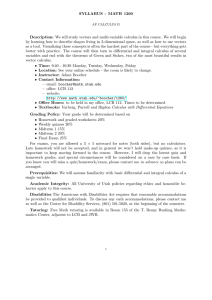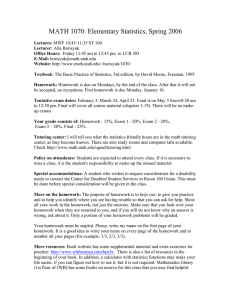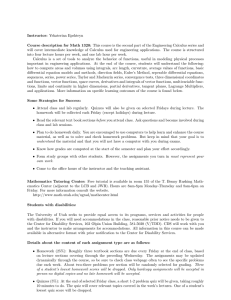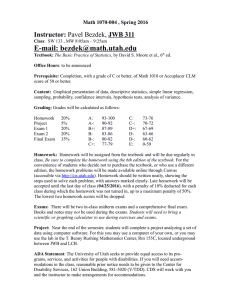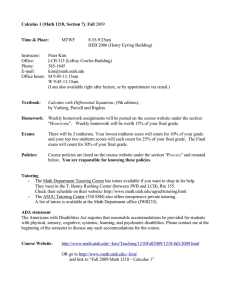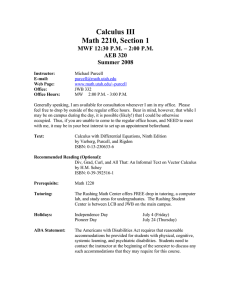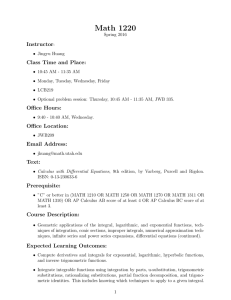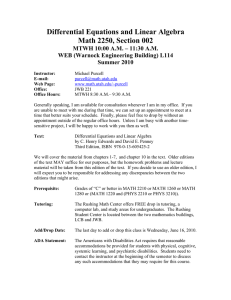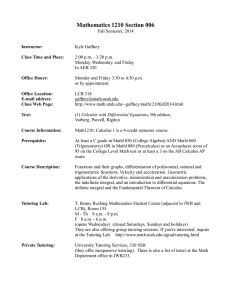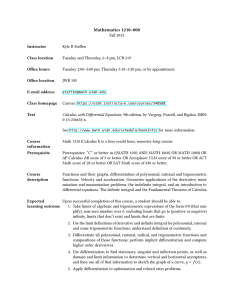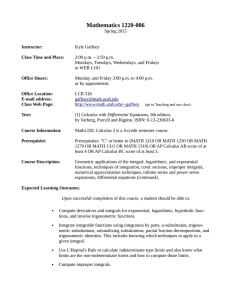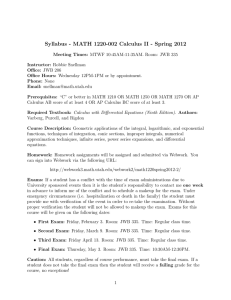MATH 1321
advertisement
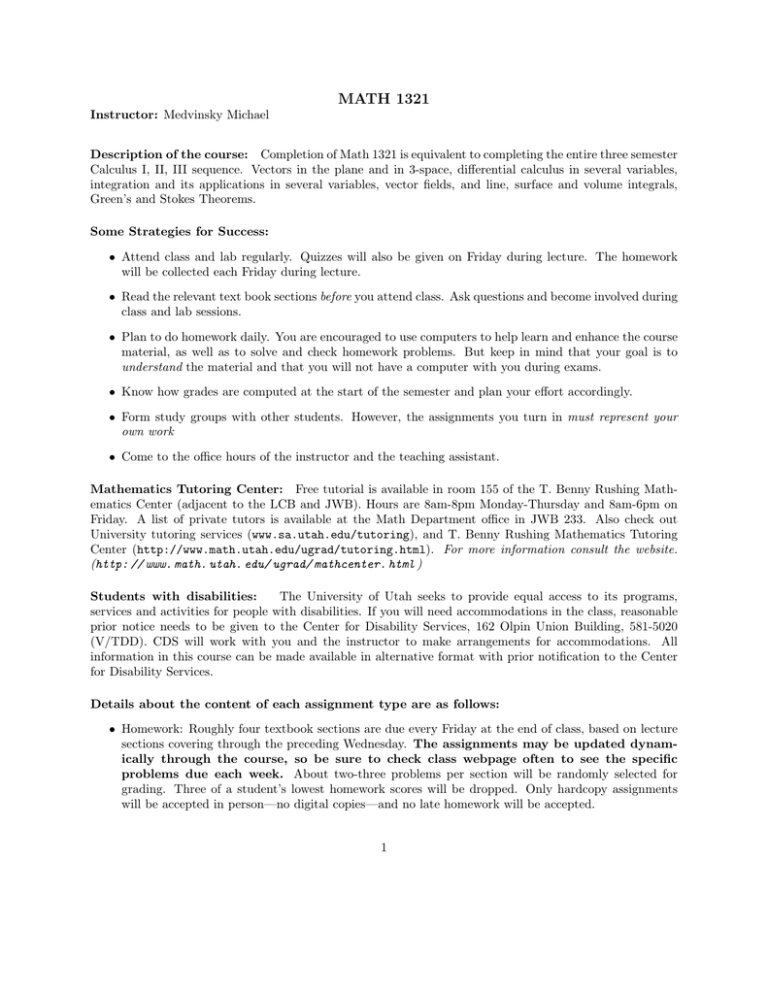
MATH 1321
Instructor: Medvinsky Michael
Description of the course: Completion of Math 1321 is equivalent to completing the entire three semester
Calculus I, II, III sequence. Vectors in the plane and in 3-space, differential calculus in several variables,
integration and its applications in several variables, vector fields, and line, surface and volume integrals,
Green’s and Stokes Theorems.
Some Strategies for Success:
• Attend class and lab regularly. Quizzes will also be given on Friday during lecture. The homework
will be collected each Friday during lecture.
• Read the relevant text book sections before you attend class. Ask questions and become involved during
class and lab sessions.
• Plan to do homework daily. You are encouraged to use computers to help learn and enhance the course
material, as well as to solve and check homework problems. But keep in mind that your goal is to
understand the material and that you will not have a computer with you during exams.
• Know how grades are computed at the start of the semester and plan your effort accordingly.
• Form study groups with other students. However, the assignments you turn in must represent your
own work
• Come to the office hours of the instructor and the teaching assistant.
Mathematics Tutoring Center: Free tutorial is available in room 155 of the T. Benny Rushing Mathematics Center (adjacent to the LCB and JWB). Hours are 8am-8pm Monday-Thursday and 8am-6pm on
Friday. A list of private tutors is available at the Math Department office in JWB 233. Also check out
University tutoring services (www.sa.utah.edu/tutoring), and T. Benny Rushing Mathematics Tutoring
Center (http://www.math.utah.edu/ugrad/tutoring.html). For more information consult the website.
(http: // www. math. utah. edu/ ugrad/ mathcenter. html )
Students with disabilities:
The University of Utah seeks to provide equal access to its programs,
services and activities for people with disabilities. If you will need accommodations in the class, reasonable
prior notice needs to be given to the Center for Disability Services, 162 Olpin Union Building, 581-5020
(V/TDD). CDS will work with you and the instructor to make arrangements for accommodations. All
information in this course can be made available in alternative format with prior notification to the Center
for Disability Services.
Details about the content of each assignment type are as follows:
• Homework: Roughly four textbook sections are due every Friday at the end of class, based on lecture
sections covering through the preceding Wednesday. The assignments may be updated dynamically through the course, so be sure to check class webpage often to see the specific
problems due each week. About two-three problems per section will be randomly selected for
grading. Three of a student’s lowest homework scores will be dropped. Only hardcopy assignments
will be accepted in person—no digital copies—and no late homework will be accepted.
1
• Quizzes: At every Friday class, a short 1-3 problem quiz will be given, taking roughly 10-20 minutes
to do. The quiz will cover relevant topics covered in the week’s lectures. Two of a student’s lowest
quiz scores will be dropped.
• Midterm exams: Two 50-minute midterm exams will be given on selected Thursdays during lab sessions.
A practice exam will be posted a week prior to the midterm that will cover the same material. Review
of the practice exam will occur both in lecture and in the lab section.
• Final exam: A two-hour comprehensive exam will be given at the end of the semester. As with the
midterms, a practice final will be posted a week prior.
• Lab: Every Thursday a Teaching Assistant (TA) -directed lab section will be held. In Lab, the TA will
hand out problem worksheets and will facilitate student-led group work. The worksheet problems will
provide guided practice with both basic calculus methods, as well as highlighting the use of calculus
in physical and engineering applications. Credit will be given for both lab attendance and completed
worksheets. Students should expect that worksheets will take additional time outside of lab to finish
completely. The TA will be available for additional office hours (for the time and place look at the
home page of the course ).
• Letter grades are determined as follows: If X is your percentage grade, then {X ≥ 93% ⇒ A; X ≥
90% ⇒ A−; X ≥ 87% ⇒ B+; X ≥ 83% ⇒ B; X ≥ 80% ⇒ B−; X ≥ 77% ⇒ C+; X ≥ 73% ⇒ C; X ≥
70% ⇒ C−; X ≥ 67% ⇒ D+; X ≥ 63% ⇒ D; X ≥ 60% ⇒ D−; X < 60% ⇒ E}.
I reserve the right to modify these in special cases and to decide if the curve is needed.
• Honor Code: You are expected to abide by the University of Utah Honor Code
2
